Science
Mysterious 'blobs' in Earth's mantle are not what we thought, study claims
Lava around the world may come from the same magma ancestor deep in Earth's middle layer, new research finds.
The study suggests that the deep mantle, where magma arises, is more uniform than scientists thought. Instead of being a stew-like mix of rock compositions, the mantle might be more like a blended smoothie — well mixed and similar throughout.
"It tells us that the mantle is probably much simpler than we were starting to think it is," said Matthijs Smit, an Earth scientist at the University of British Columbia.
Structures observed inside the deep mantle may thus not be signs of different types of rocks, but rather temperature differences in the same kind of rocks, Smit said.
The study examined hotspot lavas, which come from plumes that billow upward from Earth's deep mantle and erupt at volcanoes at the planet's surface. Samoa, Hawaii and Iceland are all hotspots. The lavas that erupt at hotspots around the globe vary in their trace elements, which scientists have traditionally interpreted to mean that the mantle has lots of distinct reservoirs of different rock which don't mix, or mix slowly, said Paul Tackley, a geophysicist at ETH Zürich who was not involved in the study. But large-scale computer models of the mantle suggest that this layer of Earth probably does mix efficiently. If that's the case, it's possible that magmas all start out the same in the lower mantle and differentiate as they rise through the upper mantle.
"We have a hundred soups," Smit told Live Science. "Do we make them from a hundred different stock cubes, or do we actually have 100 different soups that we all made from the same stock cube?"
There's no way to peer into the lower mantle directly, but hotspot lavas do have chemical signatures that give hints of their history. Smit and his colleagues looked at lava concentrations of three elements—nickel, niobium and chromium. These elements behave differently as the melts rise and change on their way to the surface: Nickel tends to become incorporated into crystals, so liquid portions of the melt have lower and lower concentrations of nickel as the melt goes through more changes. Chromium does the same on a different timeline, while niobium tends to stay in the liquid. By looking at the proportions of these different elements, the researchers could tell which lavas had gone through the most changes from their original source, and which were closer to that ancestral mantle magma.
-

 Science1d ago
Science1d agoInside Capitol Hill’s Latest UFO Hearings
-

 Science1d ago
Science1d agoYou Won’t Want to Miss the Leonid Meteor Shower. Here’s How and When You Can See It
-

 Science2d ago
Science2d agoHere’s What Trump’s Win Means for NASA
-

 Science5d ago
Science5d agoWhy Risky Wildfire Zones Have Been Increasing Around the World
-

 Science5d ago
Science5d agoIt’s Time to Redefine What a Megafire Is in the Climate Change Era
-

 Science1w ago
Science1w ago4 Astronauts Return to Earth After Being Delayed by Boeing’s Capsule Trouble and Hurricane Milton
-

 Science1w ago
Science1w agoThe Elegance and Awkwardness of NASA’s New Moon Suit, Designed by Axiom and Prada
-

 Science1w ago
Science1w agoSpaceX Launches Its Mega Starship Rocket. This Time, Mechanical Arms Catch It at Landing



























